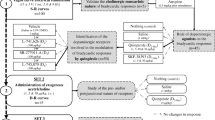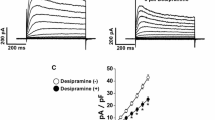Abstract
A putative 5-HT4 receptor-mediated depolarization of the rat isolated vagus nerve has been studied using a grease-gap extracellular recording technique. Ondansetron (1 μM) was used to block the predominant 5-HT3 receptor mediated depolarization in this preparation and the effects of the 5-HT4 receptor antagonists DAU 6285 (endo-8-methyl-8-azabicyclo [3.2.1] oct-3-y1-2,3-dihydro-6-methoxy-2-oxo-1H-benzimidazole-1-carboxylate HCl); 0.3, 1.0 or 3.0 μM and SDZ 205–557 (2-methoxy-4-amino-5-chloro-benzoic acid 2-(diethylamino)-ethyl ester HCl); 0.1, 0.3 or 1.0 μM were studied on the residual, ondansetron-resistant, component of the response. The effects of the phosphodiesterase inhibitor isobutylmethylxanthine (IBMX) and of forskolin on the ondansetron-resistant response were also studied.
Both DAU 6285 and SDZ 205–557 acted as competitive antagonists of the ondansetron-resistant response to 5-HT with pA2 values of 6.8 (6.7–7.1, n = 12) and 7.1 (6.9–7.5, n = 12) respectively. The vagus nerve was depolarized by IBMX (100 μM) or forskolin (10 μM), the effects being similar to the maximum response to 5-HT. In the presence of IBMX (100 μM) or forskolin (10 μM) the ondansetron-resistant component of the response to 5-HT was enhanced and the 5-HT3 receptor-mediated component reduced.
These results with DAU 6285 and SDZ 205-557 are consistent with a 5-HT4 receptor-mediated mechanism of the ondansetron-resistant depolarizing response to 5-HT.
Similar content being viewed by others
References
Arunlakshana O, Schild HO (1959) Some quantitative uses of drug antagonists. Br J Pharmacol Chemother 14:48–58
Barker D, Coleman J, Lattimer N, Rhodes KF (1994) An ondansetron-resistant component of 5-HT-evoked depolarization is present in the vagus nerves of the rat and mouse but not of the guinea-pig or rabbit. Br J Pharmacol 112:175P.
Bley KR, Eglen RM (1993) Characterization of a 5-hydroxytryptaminergic depolarization in the rat isolated vagus nerve. Br J Pharmacol 108:246P
Bley KR, Eglen RM, Wong EHF (1994) Characterization of 5-hydroxytryptamine-induced depolarizations in rat isolated vagus nerve. Eur J Pharmacol 260:139–147
Buchheit KH, Gamse R, Pfannküche HJ (1992) SDZ 205–557, a selective, surmountable antagonist for 5-HT4 receptors in the guinea-pig ileum. Naunyn-Schmiedeberg's Arch Pharmacol 345:387–393
Butler A, Hill JM, Ireland SJ, Jordan CC, Tyers MB (1988) Pharmacological properties of GR 38032F, a novel antagonist at 5-HT3 receptors. Br J Pharmacol 94:397–412
Coleman J, Rhodes KF (1993) The effect of the 5-H4 receptor antagonist DAU 6285 on a component of 5-HT evoked depolarization of the rat isolated vagus nerve. Br J Pharmacol 108:247P
Coleman J, Rhodes KF (1994) The effects of forskolin and IBMX on a putative 5-HT4 receptor-mediated depolarization of the rat vagus nerve. Br J Pharmacol 111:159P
DeLean A, Munson, Rodbard D (1978) Simultaneous analysis of sigmoidal curves: application to bioassay, radioligand assay and physiological dose-response curves. Am J Physiol 235:E97-E102
Dumuis A, Bouhelal R, Sebben M, Cory R, Bockaert J (1988) A non classical 5-hydroxytryptamine receptor positively coupled with adenylate cyclase in the central nervous system. Mol Pharmacol 34:880–887
Dumuis A, Gozlan H, Sebben M, Ansanay H, Rizzi CA, Turconi M, Monferini E, Giraldo E, Schiantarelli P, Ladinsky H, Bockaert J (1992) Characterization of a novel 5-HT4 receptor antagonist of the azabicycloalkyl benzimidazole class: DAU 6285. Naunyn-Schmiedeberg's Arch Pharmacol 345:264–269
Ireland SJ, Tyers MB (1987) Pharmacological characterization of 5-hydroxytryptamine-induced depolarization of the rat isolated vagus nerve. Br J Pharmacol 90:229–238
Rhodes KF, Lattimer N, Coleman J (1992) A component of 5-HT-evoked depolarization of the rat isolated vagus nerve is mediated by a putative 5-HT4 receptor. Naunyn-Schmiedeberg's Arch Pharmacol 346:496–503
Rhodes KF, Middlefell VC, Lattimer N, Brammer NT; Coleman J, Taylor AP, Saville VL, Ward TJ (1993) WAY 100289: Pharmacological profile of a novel 5-HT3 receptor antagonist. Drug Dev Res 28:128–140
Schiavone A, Giraldo E, Giudici L, Turconi M, Sagrada A (1992) DAU 6285: a novel antagonist at the putative 5-HT4 receptor. Life Sci 51:583–592
Author information
Authors and Affiliations
Rights and permissions
About this article
Cite this article
Coleman, J., Rhodes, K.F. Further characterization of the putative 5-HT4 receptor mediating depolarization of the rat isolated vagus nerve. Naunyn-Schmiedeberg's Arch Pharmacol 352, 74–78 (1995). https://doi.org/10.1007/BF00169192
Received:
Accepted:
Issue Date:
DOI: https://doi.org/10.1007/BF00169192




